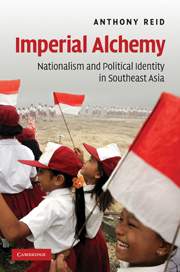Book contents
- Frontmatter
- Contents
- List of maps
- List of figures
- List of tables
- Acknowledgements
- Abbreviations
- 1 Nationalism and Asia
- 2 Understanding Southeast Asian nationalisms
- 3 Chinese as a Southeast Asian ‘other’
- 4 Malay (Melayu) and its descendants: multiple meanings of a porous category
- 5 Aceh: memories of monarchy
- 6 Sumatran Bataks: from statelessness to Indonesian diaspora
- 7 Lateforming ethnie in Malaysia: Kadazan or Dusun
- 8 Imperial alchemy–revolutionary dreams
- Glossary
- References
- Index
2 - Understanding Southeast Asian nationalisms
Published online by Cambridge University Press: 01 April 2010
- Frontmatter
- Contents
- List of maps
- List of figures
- List of tables
- Acknowledgements
- Abbreviations
- 1 Nationalism and Asia
- 2 Understanding Southeast Asian nationalisms
- 3 Chinese as a Southeast Asian ‘other’
- 4 Malay (Melayu) and its descendants: multiple meanings of a porous category
- 5 Aceh: memories of monarchy
- 6 Sumatran Bataks: from statelessness to Indonesian diaspora
- 7 Lateforming ethnie in Malaysia: Kadazan or Dusun
- 8 Imperial alchemy–revolutionary dreams
- Glossary
- References
- Index
Summary
Anti-imperial nationalism was strong in twentieth century Southeast Asia partly because there was little of the older state nationalism to balance it. Burmese, Siamese, Vietnamese, Cambodian, Aceh and Lombok kings had generated some degree of commonality with the majority people they ruled, partly by manipulating religious symbols. But unlike the Northeast Asian rulers, they employed abundant foreigners and utilised broader sacred or trade languages (Pali, Sanskrit, Arabic, Malay) often in preference to the vernacular which united them to their people.
The model for anti-imperial nationalism was the Philippines, where three centuries of Spanish rule and shared religion made the imperial unit appear persuasive as early as the 1860s. By the time of José Rizal and his fellow-ilustrados in the 1890s, the case they made in Spanish for a Filipino national unit as a focus for passionate loyalty was sufficiently convincing to dominate the anti-Spanish revolution of 1896 and the war of resistance against American occupation that followed. At more populist levels, there were naturally tremors of ethnie nationalism carried by Tagalog and Cebuano, but these never seriously shook the conviction that the boundaries established by colonial fiat were the correct ones.
Indonesian nationalism, as we shall see, initially coexisted with embryonic Javanese, Minangkabau, Batak and Minahasan ethnie nationalisms. But without the stiffening of state nationalism, these were quickly swallowed up in the anti-imperial mood.
- Type
- Chapter
- Information
- Imperial AlchemyNationalism and Political Identity in Southeast Asia, pp. 25 - 48Publisher: Cambridge University PressPrint publication year: 2009



